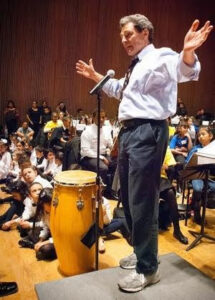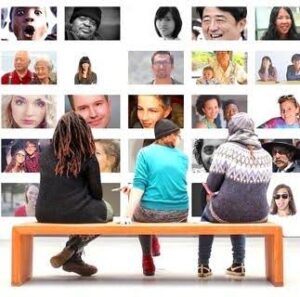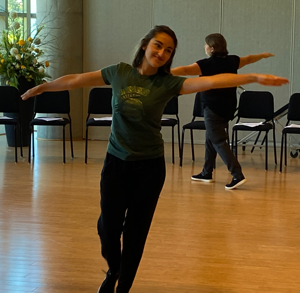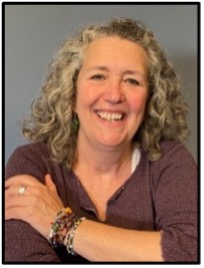“Everyone brims with artistry. There is an entire profession dedicated to activating people’s artistry for a range of purposes – Teaching Artists. These professionals know how to awaken artistry. They know how to develop it. They know how to guide it toward positive results that matter.” ~ Eric Booth
In the world of arts education, there are professionals working outside the boundaries of school buildings to uncover and inspire imagination and artistry in others. These professionals are most often titled teaching artists, but are also known as community artists, culture bearers, social practice artists, participatory artists and more. They are working in community centers, prisons, museums, libraries, hospital and care facilities, and yes, schools. They are working globally and right here in the greater Lansing area.

Eric Booth
Eric Booth is widely regarded as the father of the teaching artist profession. He is an author, educator, actor, arts leader and he has been a teaching artist for more than 40 years. He notes that teaching artists weave together separate domains; the skills of an artist and an educator working together in dynamic excitement. He explains the difference between a teaching artist and an arts teacher as a difference in purpose. “The purpose of an arts teacher is to bring learners into the traditions and excellence and understanding of a particular art form. The number one job of the teaching artist is to activate the artistry of other people – and when that innate power in all human beings to make stuff they care about is awakened, it can be channeled in many different directions. That is why the field of teaching artistry is so broad. It has appeared organically in every country of the world to accomplish different ends.”
To help focus the broad field, Booth outlines six purposes of teaching artistry. To:

- develop important personal or social capacities.
- enhance the life of the community.
- impact political and social movements.
- achieve goals important to non-arts institutions.
- deepen development in artmaking skills.
- boost the learning of non-arts subjects.
- enrich encounters with art works.
Many of these purposes align closely with MAEIA’s unfolding collective impact initiative, MI Creative Potential. Its’ purpose is supporting equitable access to quality arts education in Michigan through data collection, implementation of resources, strategic partnerships, and a statewide arts action agenda. In a collaborative spirit, MAEIA is working in partnership with the Michigan Arts and Culture Council, Michigan Education Association, and Michigan Department of Education with endorsements from state arts and education associations to develop and grow MI Creative Potential. MAEIA recognizes and supports an ecosystem of arts and education that is rich and deep; artists and educators, and teaching artists engaging in work across the state that leads to fostering vibrant communities, building our best workforce, fueling our creative economy, and supporting health and wellness.
In an effort to achieve these important purposes, we can look to Booth’s outline of the fundamentals of teaching artistry. He notes that these inclinations, understandings, capacities and habits of individuals engaged in varying environments help define the work.
Fundamentals of Teaching Artistry
 Activating the artistry of others – when activated, this “human power generator” can be guided to accomplish a wide range of goals from classrooms to hospital rooms to prison cells to places of worship and to the halls of politics.
Activating the artistry of others – when activated, this “human power generator” can be guided to accomplish a wide range of goals from classrooms to hospital rooms to prison cells to places of worship and to the halls of politics.- Adeptness with the creative process – there is a destination, but it’s all about the journey.
- Creating safe and brave environments for engagement – making a place that is challenging, fun, energizing, brave, joyful, and sensitively attuned to each individual in the room.
- Deftness with inquiry – creative engagement is a co-learning inquiry process that begins in interest and curiosity and leads towards making those qualities lifelong habits of mind.
- Authenticity – a teaching artist’s greatest impact comes from bringing their artist-selves into the room; openly seeing, responding, discovering and creating connections with what is happening in real time.
- Imagining meaningful new worlds – following a relentless urge to reach beyond the literal, beyond right answers, standard solutions, and existing opinions and judgements to see the world as if it could be otherwise and living to bring that new world into being.
 MI Creative Potential parallels the work of teaching artists as it endeavors to bring people inside of the artistic experience with a method for leveraging arts activities for social justice and social good, thus enhancing and improving the life of the individual and the community. To achieve this important goal, MAEIA is excited to work with partners to develop a statewide network to support arts education. Currently there is an online teaching artist roster sponsored by the Michigan Arts and Cultural Council.
MI Creative Potential parallels the work of teaching artists as it endeavors to bring people inside of the artistic experience with a method for leveraging arts activities for social justice and social good, thus enhancing and improving the life of the individual and the community. To achieve this important goal, MAEIA is excited to work with partners to develop a statewide network to support arts education. Currently there is an online teaching artist roster sponsored by the Michigan Arts and Cultural Council.
The impact of arts and creativity is undeniable across the globe and over the decades. The individuals and organizations endeavoring to do this artistic work bring a treasure trove of qualities and experiences that propose to make things better. The teaching artist strives to empower and grow creativity and artistry that supports a positive impact. MI Creative Potential plants itself firmly in this work while encouraging and supporting the artistic and creative growth of individuals and communities. MAEIA can agree with Eric Booth when he says,
“The role of a teaching artist is not merely defined as a particular type of job, it is a way of thinking and functioning.” And so is MI Creative Potential.
___________________________________________________________________________________________________________
 Joni Starr serves as the MAEIA Blog Editor and Researcher for assessment prompt material. She is also an Arts Integration Consultant for Ingham Intermediate School District and a Teaching Artist with Wharton Center for Performing Arts. Joni spent 10 years teaching at Michigan State University sharing time between the Theatre and Teacher Education departments. She has experience in theatre production, curriculum development, formative assessment, and teacher professional development in arts integration and creativity in the classroom. She is also the founder of and lead facilitator at Creekside Gathering Place.
Joni Starr serves as the MAEIA Blog Editor and Researcher for assessment prompt material. She is also an Arts Integration Consultant for Ingham Intermediate School District and a Teaching Artist with Wharton Center for Performing Arts. Joni spent 10 years teaching at Michigan State University sharing time between the Theatre and Teacher Education departments. She has experience in theatre production, curriculum development, formative assessment, and teacher professional development in arts integration and creativity in the classroom. She is also the founder of and lead facilitator at Creekside Gathering Place.
References
- Making Change, Teaching Artists and Their Role in Shaping a Better World by Eric Booth.
- The Everyday Work of Art, Awakening the Extraordinary in your Daily Life by Eric Booth.
- Roles of Certified Arts Educators, Certified Non-Arts Educators and Providers of Supplemental Arts Instruction, SEADAE Arts Education White Paper

Leave a Reply
You must be logged in to post a comment. Don't have an account? Register Here.